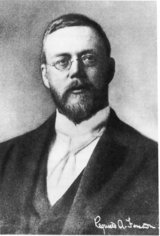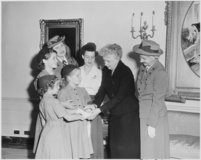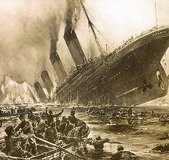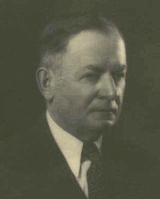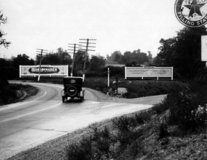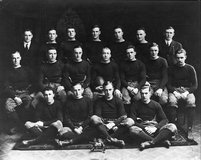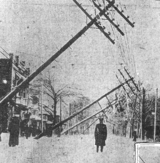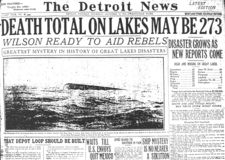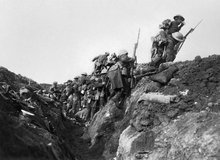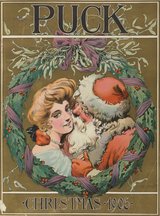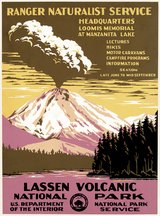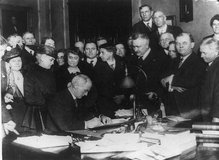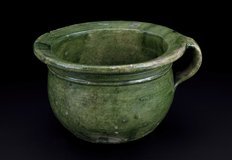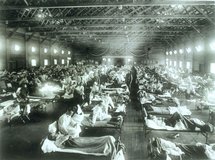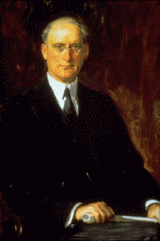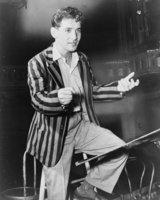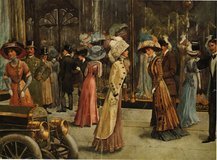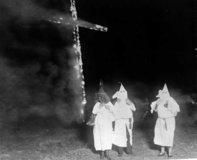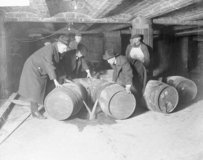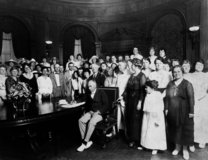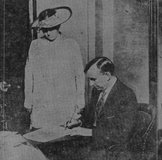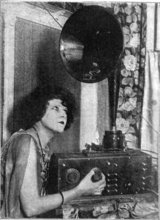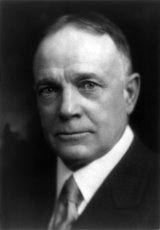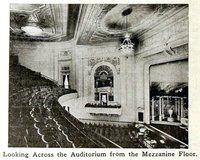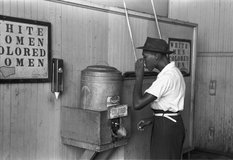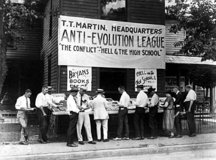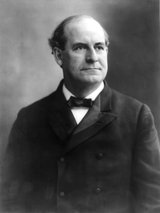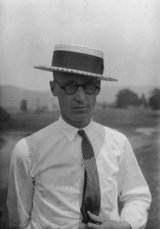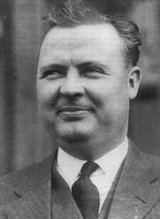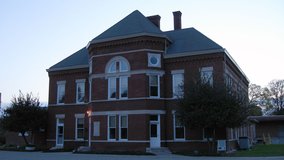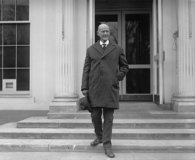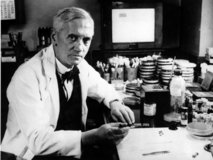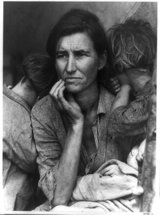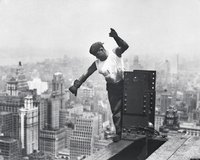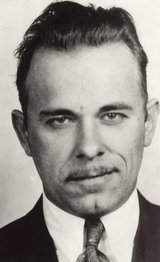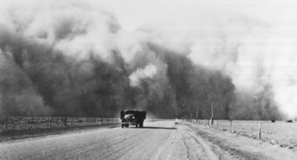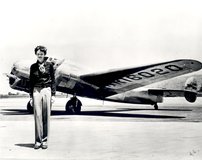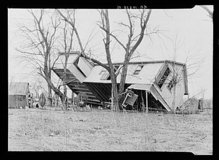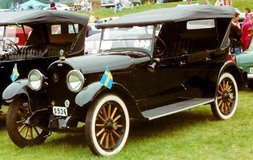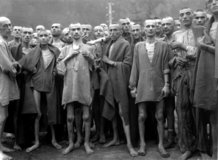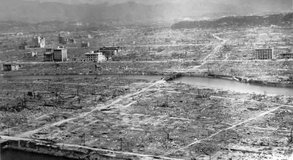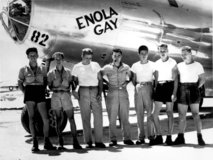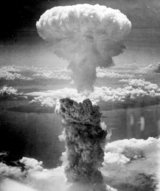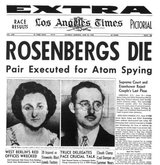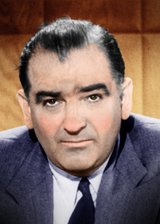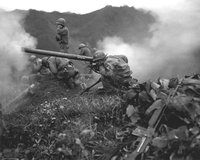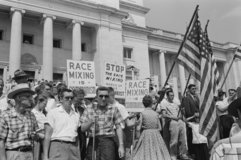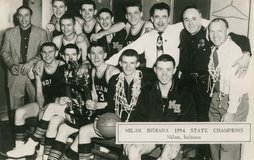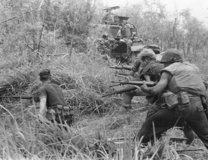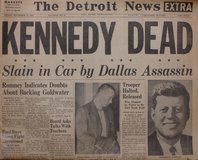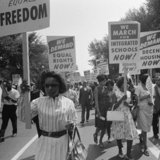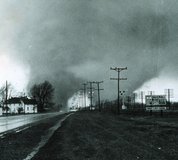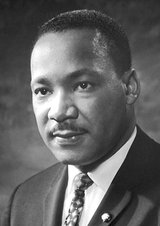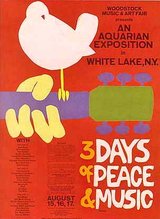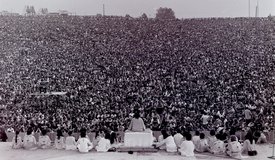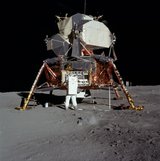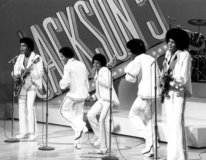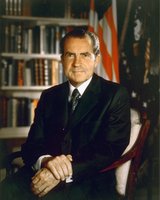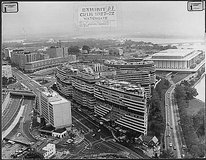©2025 HistoryLines, 2270 US Highway 30, Oswego, IL 60543.
Stella M Barber
-
Childbirth
-
Childhood
-
Clothing
-
Commerce
-
Communication
-
Diet
-
Education
-
Entertainment
-
Holidays
-
Household
-
Hygiene
-
Jim Crow Laws
-
Marriage
-
Medicine
-
Military
-
Politics
-
Religion
-
Transportation
-
Stella M is born in Delaware, Indiana, United States
-
Indiana Becomes a center of the automotive industry in America
-
The first radio broadcast is sent from Massachusetts
-
The first Indianapolis 500 is held, soon to become one of the most prestegious event in auto racing
-
The RMS Titanic sinks after hitting an iceberg in the north Atlantic Ocean
-
America's first transcontinental highway is built
-
Notre Dame Football popularizes the forward pass
-
A large winter storm devastates the Great Lakes region
-
The Great War reaches Indiana
-
President Wilson creates a new agency to protect America's parks
-
Indiana becomes a dry state ahead of the rest of the nation.
-
The Spanish influenza pandemic strikes Indiana
-
Indiana bans the use of the German language
-
The KKK arrives in Indiana and becomes a major force
-
The 18th Amendment prohibits alcohol production in the United States
-
Women in the U.S. are granted the right to vote with the 19th Amendment.
-
Listeners tune in to public radio
-
John T. Scopes is accused of teaching evolution in a public school
-
Indiana passes even stricter Prohibition laws
-
Murder of Madge Oberholzer brings about fall of the Klan
-
A prominent American Socialist and leader of the Pullman Strike dies
-
Alexander Fleming discovers penicillin and revolutionizes the medical world
-
The Great Depression sees U.S. unemployment rate hit 25%
-
The Empire State Building is constructed in New York City.
-
Hoosiers elect liberal Democrat Paul McNutt as Governor
-
President Roosevelt passes New Deal programs to help revitalize the economy
-
"Public Enemy No. 1" begins his famous crime spree after being released from jail
-
Farmers abandon their lands after the Dust Bowl destroys crops and enhances economic strain caused by the Great Depression
-
Amelia Earhart disappears over the Pacific Ocean.
-
Flood devestates southern Indiana along the Ohio River
-
The United States joins the Allied cause against the Axis powers of Nazi Germany, Japan, and Italy
-
Over 11 million people are killed by the Nazis in organized genocide
-
Japanese planes attack Pearl Harbor naval base in Hawaii, killing 2,400 Americans
-
The U.S. drops the first atomic bombs on Hiroshima and Nagasaki.
-
U.S. Senator Joseph McCarthy heads an aggressive campaign against American citizens with supposed Communist sympathies
-
Hoosiers mobilize for the Korean War
-
Polio Vaccine is presented to the public
-
Brown v. Board of Education desegregated all public schools in America.
-
Milan High School basketball team wins state championship
-
Hoosiers fight in Vietnam
-
Mother dies
-
The Soviet Union attempts to transfer nuclear weapons to Cuba
-
President John F. Kennedy is assassinated in Dallas.
-
The Civil Rights Act outlaws racial discrimination of African-American people in employment and education
-
271 are killed and over 1500 injured in tornado outbreak
-
The Indiana Dunes National Lakeshore becomes federally protected
-
Civil rights leader Martin Luther King Jr. assassinated in Memphis
-
Thousands traveled to upstate New York for the Woodstock Music and Art Festival.
-
American astronaut Neil Armstrong becomes first man to walk on the moon
-
The Jackson 5, an R&B group from Gary, become international superstars
-
A break-in at the Democratic Party offices is tied to President Richard Nixon
-
Stella M dies at age 68.
Though many automakers were slow to adopt the mass production techniques of Henry Ford and found it difficult to compete, at its height, over 40 Indiana cities were involved in the auto industry. In 1911, the industry's heavy presence in the state gave birth to the Indianapolis 500, initially envisioned as a race where automakers could compete to see who produced the best vehicle. Unfortunately, the Great Depression, as well as the changing tastes of consumers, severely undermined the state's auto industry. By 1937, when Dusenberg closed its doors, many of the once-great companies had already shut down. Only Studebaker remained, and would continue to produce vehicles for several more decades.
Even with the rise of hospital birthing, some mothers in Stella M's town still elected to give birth at home, sometimes with a midwife. As many Indianans moved to urban areas, physician-attended births were becoming more common. Mothers in rural Indiana, as well as the poorer immigrant population, however, were still dependent on midwives to assist in childbirth, much to the chagrin of the medical profession. In an attempt to encourage expectant mothers to give birth in a hospital, obstetricians and doctors waged a campaign against midwives, claiming at-home births put the mother at unnecessary risk. Doctors argued that a standardized medical environment with the latest technology increased the chance of survival for both mother and child. The campaign had an effect, as midwife-attended childbirths decreased from 35% at the beginning of the 1900s to under 2% within a few decades.
Children in Stella M's community played a wide range of games such as baseball and football, card games, or board games including Monopoly and Scrabble. Many also joined local clubs like the Boy Scouts or Girl Scouts (founded in 1910 and 1912 respectively). With the advent of movie theaters in the 1910s and '20s, some feature films were preceded by cartoons or serials aimed at children. Characters like Mickey Mouse and Bugs Bunny soon became popular in theaters across the country. Children's radio shows like Amos n' Andy and Little Orphan Annie also had large followings.
The first race drew in a large number of entries, due to the exceptionally high winning prize; more than $10,000, which was more than even baseball's highest earning player, Ty Cobb, could claim.
Unfortunately, the first race was marred by a death and a number of other misfortunes that threw its conclusion into doubt. Sam Dickson, a riding mechanic, was killed when his driver's car crashed and rolled. The driver; however, was ejected and survived. Later in the race, scoring was disrupted when another vehicle nearly crashed into the judging booth, causing the judges to flee for their lives.
Finally, when it was over, Ray Harroun was crowned the winner and received a cash prize of $14,000. The results were shortly called into question when the runner-up, Ralph Mulford, held steadfast to his belief that he was the true winner. Despite its inauspicious start, the Indianapolis 500 quickly became one of the most famous car races in the world, gaining much prestige for Stella M's home state in the automobile sporting community.
In 1900, the average housewife spent over 44 hours per week working on meals, but by the 1920s it had dropped below 30 hours. Store-bought cereals became a popular breakfast food, along with eggs and toast. Lunch became less hearty and would often include sandwiches, salads or soup. The invention of pre-sliced bread made fixing a portable meal even easier.
During Stella M's life the most popular meal combination was meat and potatoes, accompanied by cake or pie for dessert. Casseroles were another common dinner meal, and chicken had also climbed in popularity. Hoosiers at the beginning of the 20th century were more aware of the nutritional content of their foods. Companies started to boast of the vitamins their products contained, and families had even more access to fresh produce from all over the world thanks to new methods of transportation.
The city of Gary acted as a laboratory to one of these reformers, William Wirt, who was named superintendent of the Gary school system. He introduced the innovative "Gary Plan," which called for students to receive classroom instruction for half of the day, and hands-on instruction for the rest. The Gary Plan became the model for education in many urban centers throughout the United States until the 1930s. Those of Stella M's community who attended a Gary Plan school were broken into platoons that spent half the day studying subjects like math, English, and science, and the other half of the day studying art, industrial courses, or physical education.
Despite these reforms, many problems continued to plague the school systems of Indiana. A 1923 commission found that students in rural schools still lagged behind those in towns and cities in the quality of education they received. Early on, most rural students still met in single-room school houses for elementary school, before traveling to a larger school, if they attended high school at all. Buses became more common in the 1920s, leading to districts consolidating, as students from outlying areas were brought into the cities for school, and the one-room school houses faded away. With the ascent of the Ku Klux Klan in the 1920s, and the migration of many African Americans to the state's industrial towns, there was a growing movement to segregate schools in some communities. Because many schools were based in a single neighborhood, most students attended classes only with members of their own ethnic community.
Numerous colleges operated throughout Indiana during this time, including Indiana University Bloomington, Notre Dame, and Purdue, offering an opportunity for higher education to Stella M if she could afford it.
The storm was the result of two weather patterns converging over the Great Lakes. The water in the lakes was relatively warm, and helped fuel the gale as it swept over them. Milwaukee and Chicago were buffeted by high waves, which destroyed breakwaters that had been built to protect the cities from flooding. Blizzard conditions swept over parts of Michigan, Ontario and Ohio. The city of Cleveland and southern Ontario were buried under feet of snow and ice; electrical systems were knocked out and it took days to clear the streets and return utilities. Even worse were those sailors caught by the storm on open water. Eighteen ships were lost, many with their entire crews. Eight ships went down on Lake Huron alone. The storm cost millions of dollars both in damages to coastal cities and lost ships.
Indiana supplied 130,000 soldiers to the First World War, of which 3,000 were killed. Just as during the Civil War, a draft was instituted to conscript citizens into service. Those who volunteered were able to choose their branch while also requiring a shorter period of enlistment. America mobilized so quickly that it had only 208,000 soldiers serving at the beginning of 1917, but 3.7 million by November of that same year.
At the time, combatants received four months of training at state-based camps before being sent overseas to France. American soldiers were nicknamed "Doughboys" by the Europeans because they were seen as fresh and untested by combat. These soldiers served mainly in the French region of Lorraine and were involved in the heavy fighting that brought the war to an end in 1918—an Allied victory. On the home front, many Hoosiers turned against their German-American neighbors, believing them to be disloyal and possibly spies for Germany. It was a difficult time to be German in America, or to be viewed as an immigrant.
For many in Stella M's community, the biggest holiday of the year was Christmas. December was often a time of freezing weather, usually resulting in white Christmases. Like many other Americans, Hoosiers enjoyed decorating Christmas trees, buying presents for loved ones, and spending quality time with their families. One town in particular, Santa Claus, Indiana, especially caught the holiday spirit, and locals worked to answer the countless letters delivered to their post office each year by children writing to Saint Nick. It was also during this era that Irvington, a neighborhood in Indianapolis, began to host a yearly Halloween celebration that became world famous.
While Santa Claus had long been described as having a red suit and beard, a series of Coca Cola ads during this period helped create a more distinct image of the character that cemented itself in American culture.
During these same years, Indiana was home to a growing Jewish community, and many schools and government offices began formally recognizing religious holidays like Yom Kippur and Hanukkah.
Some argued that banning the sale of alcohol would cut down on crime and improve the lives of women and children, who were viewed as most victimized by alcohol abuse at the hands of drunken husbands and fathers. Others, however, viewed Prohibition as an attack upon immigrant communities in the state, such as the Germans, who considered alcohol part of their cultural heritage.
Even before the 1917 law was in place, some counties in Indiana had already prohibited alcohol manufacture, sale, and usage. In 1908, Governor Frank J. Hanly signed a law that allowed counties to determine on their own as to whether or not alcohol remained legal.
Indiana also boasted well organized and active chapters of organizations such as the Anti-Saloon League and the Women's Christian Temperance Society. Although the state-wide law was passed in 1917, and the entire nation went dry in 1919, the conflict over Prohibition was not over in Stella M's state.
While most of the upper class had indoor plumbing at the turn of the century, lower prices on toilets, sinks, and indoor plumbing were reaching the middle class as well. In rural parts of Indiana, however, many Hoosiers continued to use chamber pots and outhouses.
During World War I, surgeons began replacing surgical cotton with a product called Cellucotton, due to its superior absorption. After the war had ended, Cellucotton pads were re-branded as Kotex sanitary napkins and were sold to women as a way of helping to improve feminine hygiene.
Indiana created the Division of Infant and Child Hygiene with the goal of minimizing infant mortality by educating citizens on the importance of maintaining a clean environment for the health and safety of children. Cloth diapers were still used, but were thoroughly cleaned to prevent the spread of bacteria or infections.
On October 9, bowing to the recommendations of the federal government, the Indiana State Board of Health banned all public gatherings. Churches remained open for prayer and meditation, but all large events ceased, and no public funerals were allowed. The city of Indianapolis closed down all public schools and canceled the city's Halloween celebrations, a move that was credited with saving countless lives. Many doctors across the state were unable to keep up with the strain the pandemic put upon them, and sometime paid for patient's medication out of their own pockets. Meanwhile, The Star newspaper in Indianapolis ran advertisements asking local women to take nursing classes at the Red Cross, stating that nurses were more important than doctors due to the lack of treatments available. By the time the Spanish flu had run its course there were 350,000 cases in the state and roughly 10,000 deaths. The severity of the pandemic left a lasting scar on many of the people in Stella M's community who lived through this dark and troubling time.
Clothing materials and styles typically differed by class. Rich and upper-middle-class Indianans were more willing and able to take part in the fashion trends of the era. Poorer people might own a single nice gown or suit, but men would more often wear working clothing, and women would wear simple dresses made of rougher materials. In rural areas, older styles predominated. The invention of new washing machines, including the earliest electric models, made washing clothes quicker and more efficient for some families, though only the wealthy could usually afford them. The majority of people still used a simple, corrugated metal washboard over a basin to clean clothing by hand with soap and water.
One of these men was D. C. Stephenson. In 1920, when Stella M was 14, Stephenson was charged with organizing a Klan chapter in Indiana. Under his leadership, membership in the KKK soared; at its height roughly 30 percent of native-born white men in Indiana were members. Stephenson used these numbers to influence elections and public officials, making himself the most powerful man in the state, openly stating he was so powerful that "I am the law in Indiana."
The Klan was able to rise to such spectacular heights because it exploited the fears and anxieties felt by many of Stella M's fellow Hoosiers. Instead of targeting only African-Americans as had the Klan of old, the new group presented itself as an organization fighting for moral purity and Americanism. Its targets included Germans, Jews, Catholics, Socialists and others who were not White Anglo-Saxon Protestants. The influence of the Klan upon Indiana and Stella M's community would have been impossible to ignore in the 1920s.
In 1920, the Pittsburgh company Westinghouse (one of the largest radio manufacturers in the nation) devised a plan to sell more radios. They decided to make a broadcasting transmitter that would allow radio owners throughout the region to tune in for different programs. To make this dream a reality, they hired Dr. Frank Conrad — a local ham radio operator who often played records over the air for his friends and listeners — to set up a broadcasting channel, KDKA. November 2, 1920, the day of the presidential election, was to be the first day of programing.
Listeners in the area who tuned in that day heard a reading of the results of the presidential election, where Harding decisively defeated Cox. The broadcast, although heard by only a small group of people, was a stunning success and caused radio mania to grip the nation. Radio sales soon exploded throughout America, and there was a rush to open up and register commercial radio stations in most major cities. The Age of Radio had truly begun.
In most churches, women were banned from leadership roles, so they began forming more church-associated bodies such as aid societies and missionary groups. These organizations became major factors in moving forward some of the key issues of the 20th century, including alcohol prohibition and relief efforts during the Great Depression.
While some religious organizations in Stella M's community took aim against what they saw as "immoral" music and art, there were also church groups that were instrumental in helping form the Indianapolis Symphonic Orchestra and other important artistic pillars of the region. The arrival of the radio also gave local evangelists a new platform for speaking to their followers. One of the most successful of these was Billy Sunday, a former baseball player who became one of the most popular preachers in the United States until his death in 1935. Sunday often preached against the use of liquor and traveled across the nation spreading his message.
Stella M's fellow Hoosiers also had a wide variety of sporting events to attend, such as college football, local farm league baseball, and high school and collegiate basketball games—a sport which would come to be widely associated with the region. The circus also remained a prominent presence in the state, as many of the major companies made stops there.
In terms of music, jazz continued its ascent as Indiana entered into the Roaring 20s, with Gennett records publishing many of the prominent jazz and folk artists of the era. The nightclub scene of Indiana Avenue in Indianapolis drew many of the greatest musicians of the time, and album recordings—played on a gramophone—allowed listeners to purchase some of their favorite tunes.
Madge Oberholzer first met Stephenson at the inaugural ball for Governor Ed Jackson, a Klan backed candidate who had won Indiana's governorship. Madge was 28 years old, still lived with her parents and was manager of the Indiana Young People's Reading Circle. The two began to date frequently, and she began to act as his aide when the Indiana Assembly was in session.
On March 15, 1925, Marge was asked to meet Stephenson on his private train. Once there, she was brutally attacked, bitten and assaulted. Eventually, in an effort to make the attacks stop, she poisoned herself with mercury tablets. Stephenson panicked and returned her home, but it was too late. She died a month later, either from the effects of the poison, or from the abuse she had sustained. This attack horrified many members of Stella M's community and shattered the warped image of the Klan as an organization of supposed moral purity. Stephenson was sentenced to life in prison, but was paroled in 1950.
The emerging automobile industry, however, soon became the biggest contributor to Indiana's economic gains. Local companies such as Studebaker, Duesenberg, Auburn, and Stutz were some of the first automobile manufacturers in America, and turned Indiana into an early center of car culture. Facing stiff competition with Henry Ford's companies in Detroit, many of the Indiana manufacturers turned to creating luxury automobiles in the 1920s and 30s, until they were crippled by the Depression.
The Indiana University School of Medicine was also founded in 1903, becoming the fourth medical school in the United States. As American medical students began training in more specialized fields, it opened up more treatment options for patients in the decades that followed, as highly skilled experts in everything from dentistry to heart surgery used their abilities to save countless lives.
During this era, many modern utilities were becoming increasingly commonplace. Running water and indoor plumbing became available to nearly all residents by the mid-20th century, and electricity also became common in the cities, but did not reach many rural areas until the 1930s. The introduction of electricity revolutionized cooking and heating as families were able to heat their homes with electric heaters rather than relying on coal, wood, or steam.
After the war's end, a national campaign began to have him released from jail, which was done by President Harding on Christmas Day of 1921. After his release Debs returned home to Terra Haute where he was greeted by over 1,000 cheering residents. Although in bad health from his time in prison, he continued to write and make speeches, fighting for the causes to which he had dedicated his life. Following his death, Debs' body lay in state at the Terra Haute Labor Temple. Not everyone in Stella M's state agreed with Debs' Socialist beliefs, but many still recognized him as a prominent and influential Hoosier.
During the Spanish-American War and World War I, many soldiers reported to makeshift Indiana training camps, including Camp Mount outside of Indianapolis. Some training involved learning the new military technology of the period, including tanks, grenades, and weapons like the Browning automatic rifle. By 1915, the first "dogfights" between machine-gun armed aircraft occurred, and chemical weapons like mustard gas became nightmares of the battlefield.
During the First World War, a draft was instituted, just as during the Civil War. Volunteering allowed men to choose their branch while also requiring a shorter period of enlistment. At the time, combatants received four months of training at state-based camps before being sent overseas to France. These soldiers served mainly in the French region of Lorraine and were involved in the heavy fighting that brought the war to an end. After the conclusion of the war, investment in the military shrank and many men were mustered out as it returned to a period of peace. Many veterans battled with "shellshock" or post-traumatic stress disorder, but there was little recognition or appreciation for such conditions during the period.
After he was released on parole eight and a half years later, Dillinger immediately robbed a bank in the town of Lima, Ohio. Although he was quickly apprehended, three of his fellow gang members broke him out, killing a sheriff in the process. After their escape, the Dillinger gang robbed several more banks, and even raided two police arsenals in Auburn and Peru, Indiana. At the time, America was suffering from the Great Depression and many members of Stella M's community viewed gangsters such as Dillinger as Robin Hood figures who were striking back against an unfair system. The newspapers latched on to this sentiment and, while covering the daring attacks and escapes, turned men like Dillinger into folk heroes. Eventually Dillinger was cornered by the FBI while leaving a Chicago theater and died in the ensuing shootout. Despite his crimes, he remains a famous figure both in his native Indiana and throughout the nation.
On January 24th, two weeks after the disaster had begun, Evansville was placed under martial law and people scrambled to deal with the flood waters. When it was all over, six southern counties had been ravaged by the flood, resulting in nearly 13 million dollars of damage
The disaster wasn't without its heroes. In the wake of the flood, thousands of WPA workers arrived on the scene and began providing aid to the community. They removed silt from the streets, set up shelters, and rescued people and livestock. Although the disaster was great, the resolve of Stella M's fellow Hoosiers shone through as they worked to rebuild the region.
The automotive industry eventually grew so strong in Indiana that a special track was built by enthusiasts in Indianapolis to test and race vehicles. Thus, the Indianapolis 500 was born in 1911. The race eventually became internationally known—a point of pride to Stella M's community and state.
Aviation also eventually became a more feasible mode of transportation throughout the nation, though it was too expensive for most people to afford until the 1940s. During this period, many older forms of transportation such as horse-drawn wagons and carriages died out, though the railroads continued to be used as fares became cheaper.
Along with battling Japanese forces in the Pacific, Americans also joined the Allied Forces (including Great Britain, France, and the Soviet Union) to stop the rise of Nazi Germany and its fascist ally in Italy. The fighting would rage on for four years.
Indianans on the home front showed support by rationing goods and purchasing over $3 billion in war bonds. Many women worked in the ammunition and steel industries that were vital to the war effort. Additionally, many captured German and Italian POWs were sent to Indiana and put to work in neighboring industries and farms to help with the manpower shortage the war had caused. Nearly everyone in Stella M's community had a friend or loved one fighting overseas. While news reels, radio broadcasts, and newspaper articles told of various battles, telegrams informed families of the fallen. Finally, after the defeat of Hitler's Nazi regime, the U.S. elected to use two atomic bombs on the Japanese cities of Hiroshima and Nagasaki, killing tens of thousands of civilians in an act that remains controversial to this day. Japan did surrender after these attacks, and the war's end brought celebrations in the streets across America and much of the world. It was a time of great relief and joy for millions around the world. However, the scars suffered through the global nightmare of the war—and the gradual understanding of the full scope of the Nazi Holocaust against the Jewish people and other minorities in Europe—made it difficult for many people to ever fully recover.
By the 1920s, many of Stella M's friends and neighbors had embraced radio as a form of mass communication. All stations were AM, until FM emerged in the 1940s. While radio remained vital for receiving up-to-date news or listening to music, television soon became the new centerpiece of most homes. The first television sets weren't available until the late 1940s, and even then, very few families could afford the cumbersome devices. For many years, only a handful of networks existed, and most TVs projected images exclusively in black and white.
Although it took time, the library system also grew in the 20th century. For the literate population of Stella M's region, the availability of books and magazines offered a connection to the wider world. For in-depth news, local newspapers and respected national publications like the New York Times and Wall Street Journal kept the public up to date on politics, economics, culture, and more.
Almost immediately after the bombs were dropped, 39 year-old Stella M and millions of other Americans huddled around their radios to hear the details. Though some questioned whether the ends justified the means, many of the people in Stella M's life were simply relieved to know that a victory and peace were finally in sight.
After years of struggle, women finally earned the right to vote with the 19th amendment in 1920, although it was not until 1921 that the Indiana state legislature passed a bill allowing for the participation of women in state elections.
Around that same period, Indiana experienced the "First Red Scare," as fears of communism grew in the aftermath of WWI, and the racist politics of the Ku Klux Klan gained a following. There was also a growing awareness of corruption in government, especially following the many scandals of the Harding administration.
Later, when the Democratic Party gained favor during the Depression, the election of Governor Paul V. McNutt was a watershed moment in Indiana history, and he worked closely with the Franklin Roosevelt administration to bring federal relief to unemployed Hoosiers across Stella M's region. McNutt also greatly centralized the state government and increased the power of the position of governor.
The coming of the Second World War greatly affected state politics, as winning the war became the main focus of politics on the state and national level. In order to draw in needed workers on the home front, the Indiana General Assembly passed a fair employment act to restrict discrimination against women and African Americans in the workplace. Following the Allied victory, the focus of America and Stella M's fellow Hoosiers began turning towards the Soviet Union and the looming threat of communism.
Furthermore, Muncie was one of the larger schools in the state, while Milan's high school had fewer than 200 students. Going into the final seconds, the score stood tied at 30-30. Then, as the last second fell from the clock, Bobbie Plump, a Milan player, hit a jump shot to win the game 32-30. The victory brought a great deal of pride to the people of Milan, and many of Stella M's fellow Hoosiers viewed the victory as an inspirational tale. The story is still cherished by many in Indiana and became the inspiration for the hit movie Hoosiers[/] about 30 years later.
The fear of being drafted created a vibrant anti-war movement, especially on college campuses like Purdue or Indiana University. Although most Hoosiers supported the war effort, public opinion began to turn as the conflict dragged on into the 1970s. Building pressure at home and abroad eventually forced the U.S. to withdraw its forces. In 1975, the South Vietnamese capital, Saigon, fell to North Vietnam, bringing the war to an end. In the end, over 1,500 Hoosiers perished in the conflict. The Vietnam War would cast its shadow over Stella M's community for decades to come.
The Palm Sunday outbreak remains the second largest cell of storms to strike Indiana, surpassed only by the 1974 Outbreak. However, the Palm Sunday storms killed more people than the later outbreak. The storm touched the lives of many, including Stella M's fellow Hoosiers, and it is remembered to this day.
Stella M was 62 at the time of King's death, and shock spread throughout her community and the entire country. Millions mourned the loss of the Civil Rights leader and worried about what his death would mean for the future of the movement. Ultimately, King's empowering speeches, encouragement of non-violent protests, and dream of racial equality would influence Americans for generations to come.
Lasting three days, the peaceful but drug-filled and disorganized event came to represent much of what people both appreciated and disliked about the hippies. It also may have helped introduce Stella M and others to some of the era's most influential songwriters and musicians.




